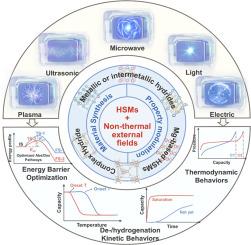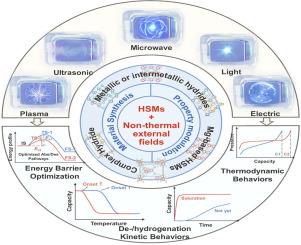高密度储氢材料的非热外场驱动合成及性能调制
IF 20.2
1区 材料科学
Q1 CHEMISTRY, PHYSICAL
引用次数: 0
摘要
固态储氢材料(HSM)因其体积氢密度高、安全性强而备受关注。然而,高温合金的脱氢化反应过程主要受热能控制,其中热交换是可逆储氢的根本动力。虽然传统的热驱动方法对某些金属氢化物是有效的,但当应用于具有强化学键和高稳定性的轻质高密度hsm(如mg基hsm、复杂hsm和轻质金属氢化物)时,它们的驱动效率有限。相比之下,新兴的非热能输入策略,如外场驱动技术(如等离子体、超声波、微波、光和电场),已经显示出超越传统热激活hsm的创新潜力。这些先进的技术不仅促进了材料的合成,而且显著降低了脱氢/加氢的操作温度,同时提高了反应动力学,从而可以精确控制储氢行为。本文系统总结了近年来非热输入外场驱动材料合成和高密度hsm脱氢化行为调制的最新进展,并对这些非热输入外场的潜在增强机制、各自的优势/局限性、材料/功能适用性、近期可行性和长期意义进行了深入讨论。并概述了下一代hsm的未来优化策略和潜在的可扩展应用。本文章由计算机程序翻译,如有差异,请以英文原文为准。


Non-thermal external field-driven synthesis and performance modulation of high-density hydrogen storage materials
Solid-state hydrogen storage materials (HSM) have attracted significant attention due to their high volumetric hydrogen density and enhanced safety. However, de/hydrogenation reactions processes of HSM are primarily governed by thermal energy, where heat exchange serves as the fundamental driving force for the reversible hydrogen storage. While conventional thermal driving methods are effective for certain metal hydrides, they demonstrate limited driving efficiency when applied to lightweight high-density HSMs with strong chemical bonds and high stability, such as Mg-based HSMs, complex HSMs and lightweight metal hydride. In contrast, emerging non-thermal energy input strategies like external field-driven techniques (e.g., plasma, ultrasonic, microwave, light, and electric fields) have demonstrated innovative potential beyond traditional thermal activation for HSMs. These advanced techniques not only facilitate material synthesis but also significantly reduce operating temperatures for de-/hydrogenation while enhancing reaction kinetics, thereby allowing precise control over hydrogen storage behaviors. This review systematically summarizes recent advances in non-thermal input external field-driven material synthesis and de-/hydrogenation behavior modulation of high-density HSMs, provides in-depth discussions on the underlying enhancement mechanisms, respective advantages/limitations, material/functional applicability, and near-term feasibility as well as long-term implications of these non-thermal external fields, and outlines future optimization strategies and potential scalable applications for next-generation HSMs.
求助全文
通过发布文献求助,成功后即可免费获取论文全文。
去求助
来源期刊

Energy Storage Materials
Materials Science-General Materials Science
CiteScore
33.00
自引率
5.90%
发文量
652
审稿时长
27 days
期刊介绍:
Energy Storage Materials is a global interdisciplinary journal dedicated to sharing scientific and technological advancements in materials and devices for advanced energy storage and related energy conversion, such as in metal-O2 batteries. The journal features comprehensive research articles, including full papers and short communications, as well as authoritative feature articles and reviews by leading experts in the field.
Energy Storage Materials covers a wide range of topics, including the synthesis, fabrication, structure, properties, performance, and technological applications of energy storage materials. Additionally, the journal explores strategies, policies, and developments in the field of energy storage materials and devices for sustainable energy.
Published papers are selected based on their scientific and technological significance, their ability to provide valuable new knowledge, and their relevance to the international research community.
 求助内容:
求助内容: 应助结果提醒方式:
应助结果提醒方式:


